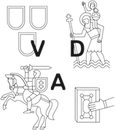
THE RETURN
Returning to a childhood experience means returning to a memory, to a certain state of dual experience. Though, running away from the current times to an untroubled childhood experience means rather to run away from than to run towards. An outlook towards memory firstly highlights the discontent over the present, and only eventually the utopian vanquishing of such discontent. A memory of childhood bliss is a remoulded image within the mind of an adult, the image suited for the needs of the dissatisfactory present. It is not a return to childhood, certainly, but to a memory of childhood, enriching it with what is lacking today. Between a childhood experience and its memory-induced image, between yet untroubled existence and return thereto as a suspension of today’s problems, there lies a far-reaching abyss. The childhood and return thereto are not alike. The main advantage of childhood relived through memory is possessing what is impossible when one is a child – the ability to consciously grip the uniqueness of the everyday experience. A child is unaware of their joys and losses being gifted a dimension of happiness or distinctness; and when one does become aware, one is no longer a child. Such is the formula of childhood happiness, found not while in possession, but after having possessed. From this viewpoint, a happy childhood is a paradoxical given with which a person never comes into contact, especially when one is a child. Maturity is gifted with a double-edged advantage: it includes childhood, but just the lost one.
So, what exactly is The Return, the present glancing backwards? The experience of a retrieved childhood is fundamentally conflicting: it does not recognise its distinctness, is unaware of its happiness and once it does become aware, it is no longer childhood and only feels the happiness in the shape of a loss to be sought. Such experience could be said to be achingly unreal if it were not the only available option, if the dream to retrieve the childhood would not be accompanied by the awareness of the memory of joyful childhood being the only available happiness of childhood. The project includes the need to look at the world through the eyes of a child, the look that is so natural, so human, yet inevitably followed by a sigh of having entered maturity. The return to childhood, even for a little, is only possible with the experience that is a stranger to childhood. Simply put, the desire to become a child is always the desire of an adult. Art is beautiful. And uncanny for its demand to look deep within oneself: whose inner child still is play like and whose soul itself is a dead child? The maturity of a person is defined by the loss of childhood; the shape of present which retrieves the most charming stuff from the past, from the flashbacks of childhood, but the latter are given to a person only in the form of dearth shrouded by a dream, of extreme and unsurpassable boundary. Perhaps art has been given the power to dream about childhood, but the dream is inevitably utopian, therefore, unimplementable, hence even more attractive.
The dream of a happy childhood is a universal method of solving contemporary problems by projecting a happy past toward a better future. The Return is not just philosophising about the importance of childhood through art. It is also a very specific, deeply painful dream about a war-torn home, lost relatives, and fragile hope to retrieve it. A wish to return to a pre-war reality, suddenly so desirable but, needless to say, unattainable just like childhood. The Return asks to reach for above, at least in thought to stand with Ukrainians who are paying a heavy toll for the things they believe in and fight for. Yes, primarily the project shares hope, but the waving of its flag hides the price of the desired future. Such is the nature of hope – seeking the future without accepting the present. Hope and tragedy of war, the price to be paid, and the belief that every loss has not been in vain. And even if the yellow blood staining the flags is just a symbol, it does remind us of the true blood that is being shed in Ukraine. The Return is an act of solidarity by the Vilnius Academy of Arts and artists from Kaunas. The act that is not straightforward in form, but direct in contents – We stand with Ukraine.
Stanislovas Mostauskis
Author of the exhibit: Saulius Paliukas (VDA Kaunas Faculty)
Architect/curator: Rimantas Giedraitis (VDA Kaunas Faculty)
Soundtrack author: Volodymyr Antoniv (Poland/Ukraine)
Motion choreographers: Dovilė Petkūnaitė, Mantas Stabačinskas
Organisers: Jonas Audėjaitis, Rimantas Giedraitis (VDA Kaunas Faculty)
Antrosios ekspozicijos atidarymo performansas






































